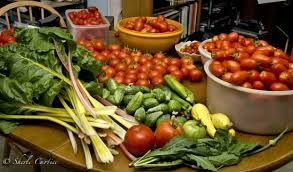
In general, larger plants and trees need less frequent but deeper watering than smaller annual plants. Avoid watering by hand. Most people don’t do it thoroughly or deeply enough. Set up drip systems, soaker hoses and sprinklers for specific areas. If you use an automatic controller, check it regularly to be sure it is working correctly.
Water plants early in the day so any wet foliage has time to dry before evening. Don’t water during the hottest part of the day or when the wind is blowing or you’ll lose a lot to evaporation.
Mulching around perennial plants and trees helps conserve moisture and discourages weeds. Keep mulch a few inches away from tree trunks and woody stems to prevent crown rot and other fungal diseases.
If you are growing California native plants, research their water needs before irrigating. Some California natives appreciate a bit of water during the dry season, but many are dormant now and will fare poorly if irrigated.
In the vegetable and annual flower beds, deep-rooted plants like tomatoes should be watered well at least once a week. Shallow-rooted plants require shorter but more frequent watering, two or more times per week.
Fire danger is high in July. If you haven’t already done so, consult the Napa Firewise website (www.napafirewise.org) for tips on making your home and property as fireproof as possible. Mow weeds and grass regularly until they stop growing. Remove dead and dry material from shrubs and trees, and dispose of this flammable debris in your yard-waste bin. Stack firewood away from structures, and trim tree branches away from your roof. The Napa Firewise website has many other suggestions for creating defensible space around your home.
To promote more blooms, deadhead flowering plants regularly. Clean up all fallen fruits, vegetables, clippings and flower petals to eliminate homes for insects and snails and to discourage disease. Add this debris to your compost pile.
This month you should be reaping lots of fruits and vegetables. Depending on your spring planting, you might be harvesting basil, beans, beets, carrots, parsnips, leeks, chard, cilantro, cucumbers, squash, lettuce, kale, parsley, peas, tomatoes, peppers, eggplant and tomatillos. In the orchard there may be figs, peaches, nectarines, plums, prunes, apples and pears. Keep up with harvesting to have the best-quality produce for your table. If you have more than you can use, share with a neighbor or the food bank.
With the vegetable garden growing so well, now is a good time to fertilize. If you are using a commercial product, follow package instructions. Granulated fertilizers can be sprinkled around plants, scratched into the top inch of soil and then watered in well. Liquid fertilizer such as compost tea is easy to apply and gives your plants a much needed boost this time of year.
While you’re at it, give citrus trees a feeding, too.
There is still time to plant marigolds, petunias, sweet alyssum and zinnias. Check with a local nursery for more ideas to brighten your flower beds.
In the vegetable patch you can still sow seeds of beans, corn, lettuce, summer squash, cucumbers, cilantro and dill. Set out basil, lettuce and chard seedlings. When in doubt about whether there’s enough growing season left, check the “days to maturity” on the seed packet or plant label. We typically have warm weather through the end of September or middle of October, enough time for many vegetable seeds to sprout and produce a crop.
You can also begin planning now for the fall and early winter garden. If you like to grow vegetables from seed, late July is a good time to start broccoli, cauliflower, cabbage and kale.
With so much to do in July, it’s a good thing that the days are long. Pause often to enjoy what grows in your garden. Make notes on what’s doing well and what you want to do differently next year. When planning the summer garden next winter, you’ll be glad you did.
Vegetable Workshop: Napa County Master Gardeners will lead a workshop on “Cool Season Veggies” on Sunday, August 18, from 2 p.m. to 4 p.m. at the Yountville Community Center, 6516 Washington Street, Yountville. Grow your own vegetables even when days are short and nights are cold. The key is starting while weather and soil are still warm. Learn which vegetables will thrive in cooler temperatures, how to protect them from heat when they are getting started, and how to time plantings for months of harvest. $15 per person ($10 for Yountville residents). Register through Town of Yountville, Parks and Recreation: Mail in or Walk in registration (cash or check only). For additional information, call (707) 944-8712 or visit their web site.
Master Gardeners are volunteers who help the University of California reach the gardening public with home gardening information. Napa County Master Gardeners ( http://ucanr.org/ucmgnapa/) are available to answer gardening questions in person or by phone, Monday, Wednesday and Friday, 9 a.m. to Noon, at the U. C. Cooperative Extension office, 1710 Soscol Avenue, Suite 4, Napa, 707-253-4143, or from outside City of Napa toll-free at 877-279-3065. Or e-mail your garden questions by following the guidelines on our web site. Click on Napa, then on Have Garden Questions?